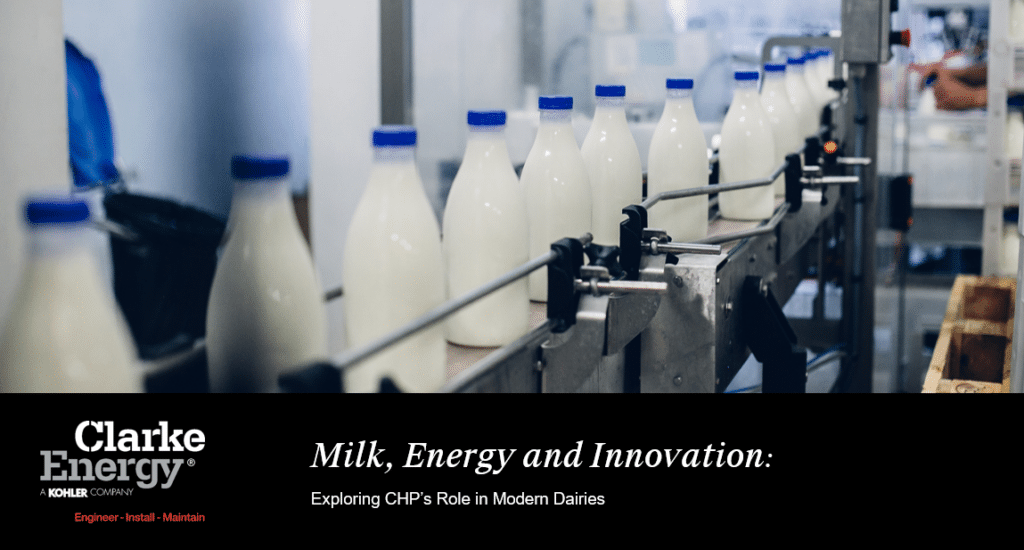Combined Heat and Power (CHP) or cogeneration continues to show significant potential in the dairy industry for reducing carbon emissions and fuel costs. Modern advancements have further enhanced these systems, making them more efficient and adaptable to a range of energy sources, including renewable options.
Benefits of CHP for Dairies – Updated Insights
- Energy Cost Savings: With advancements in technology, the overall efficiency (electrical and thermal) of CHP systems can now exceed 95 percent. This is achievable using a broader range of fuels, including biogas from dairy waste.
- Resilient and Robust Power: The reliance on the grid is further reduced with modern CHP systems, providing more stable and reliable power essential for 24/7 dairy operations.
- Environmentally Friendlier: Enhanced CHP systems produce less fuel per MW generated with even lower CO2 emissions. Newer models are designed to sustain lower emission levels while eliminating system water requirements.
- Standardized Design: Contemporary CHP systems offer more compact designs, easily customizable to specific spatial requirements of different dairy operations.
- Flexible Power Usage: Integration with smart grids and energy management systems allows for more efficient storage and utilization of thermal energy. Electricity generated can either be used onsite or fed into the public grid.
The Role of CHP in the Dairy Industry – A Global Perspective
With milk production being a critical component of global agriculture, the importance of energy-efficient practices has become more pronounced. In the European Union, which is a major producer, the focus on sustainable energy solutions in dairy processing is growing, especially with the increasing demand for products like milk powder.
Vitalait’s CHP Plant in Tunisia: A Case Study
The Vitalait dairy in Tunisia serves as a model for energy efficiency in the dairy industry. It features a 1.8MW Jenbacher J612 gas engine connected to an exhaust heat steam boiler, supplied by Clarke Energy. This setup exemplifies the effective use of CHP in optimizing energy utilization in dairy processing.
Danone’s Microgrid-Based Energy Solution Being Developed in South Africa
Moshesh Partners and Danone are developing an innovative, resilient energy system for Danone’s dairy in Boksburg, South Africa. Here a CHP plant is being combined with solar PV, a microgrid controller and back up gensets to give resilient local energy.
Updated Potential of CHP in Dairies
- Low Temperature Processes: Modern CHP systems can effectively support processes requiring lower temperatures, such as pasteurization, by using waste heat more efficiently.
- Trigeneration for Cooling: Utilizing waste heat for refrigeration through absorption chillers remains a key feature. Innovations in this area have led to more efficient conversion of heat into cooling, vital for dairy storage requirements.
- Steady Energy Consumption: The continuous operation of dairies makes them ideal candidates for CHP systems, allowing for more predictable and efficient energy use.
Integration with Other Microgrid Technologies
- Renewable Energy Sources: Integration with solar and wind power can complement CHP systems, providing a more diverse and sustainable energy mix.
- Energy Storage Systems: Incorporating battery and thermal storage can optimize the use of generated energy, ensuring a constant energy supply and enhancing overall efficiency.
- Smart Grid Technologies: Advanced control systems can manage the interplay between CHP, renewable sources, and storage, optimizing energy usage and reducing costs.
Conclusion and Future Directions
The integration of CHP with other microgrid technologies presents a comprehensive approach to energy management in dairies, promoting sustainability and efficiency. With continuous advancements in technology, the potential for CHP in the dairy industry is expanding, offering promising solutions for environmental and economic challenges.
For more information or project evaluation regarding CHP in dairies, please feel free to contact us and get in touch with a local sales representative.





